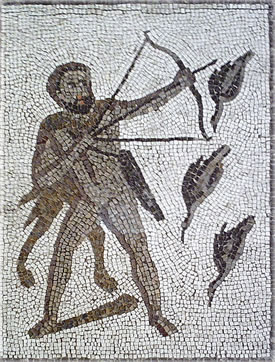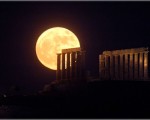
Full Moon rising above Cape Sounion, Greece. Photo by Anthony Ayiomamitis.
Editor’s Note: Gary Caton is a specialist in observational astrology — an earlier kind of navigation by the stars and planets that depends on what you can see. He will be doing our Full Moon article each month teaching this method, telling you about what is visible in the night sky. Anthony Ayiomamitis is our friend in Greece, and he is a photographer-astronomer who takes many photos near the ancient temples that dot the land of his country. I consider him an honorary astrologer. — efc
The Capricorn Full Moon is exact Friday, July 15 at 2:40 am EDT. One beautiful thing about the Full Moon is that more than most of the events astrologers write about, it’s almost always visible. Even if it’s not, Full Moon energy is so obvious that everyone who is vaguely sensitive, or who deals with the public, can feel its energy.
Traditionally, the Full Moon of July is sometimes called the Buck Moon or Hay Moon. This is because after the flowering of the Earth in May, and the subsequent growth spurt in June, it is now time for farmers to make the first cut of hay. When this is done, animals such as deer have much less hiding space and can be seen more readily in the open fields. A glimpse of a male or buck deer at this time of year shows a dramatic transformation as he has sprouted horns on his head much like fields have sprouted hay and grain — and their furry texture matches the color of wheat.
Another name for this month’s Full Moon is the Thunder Moon, because thunderstorms are most likely during the warm summer months. Visually, the most noticeable thing about this Full Moon is that it is at its lowest appearance in the sky all year.

Summer Triangle. From Wikipedia.
From the perspective of the Earth, the Sun and Moon are about the same size. They alternately illuminate day and night, and they form a dichotomous pair in other significant ways too. As the Sun reaches his highest appearance in the sky during summer, the Moon is making her lowest appearance and is closest to the horizon when full. Conversely, in wintertime when the Sun is low in the sky at noon, the Full Moon passes almost directly overhead.
So, while you will see the Sun rise more toward the northeast at this time of year, the Moon rises toward the southeast. At midnight she will be in the south, but only about halfway up in the sky between the horizon and zenith, which is the point directly overhead — that is to say, a little lower than you might expect. What you will see near midnight if you continue looking up, until you are gazing directly overhead towards the zenith, is a huge asterism called the Summer Triangle. An asterism is a combination of stars that form a pattern, but which is not designated a constellation; the Summer Triangle is composed of the three brightest stars of three different constellations. Because of its position in the night sky (during Northern Hemisphere summer) it’s one of the easier things to identify.
Just about directly above the Moon you will see Altair, the brightest star of Aquila the Eagle. Altair is the 12th brightest star in the sky, brighter than any of the ‘royal stars’ which used to mark the seasonal points in the sky. Further above and to the left or east is Deneb Adige of the constellation Cygnus the Swan. Deneb is the 20th brightest star in the sky and is actually one of the most remote stars visible to the naked eye from Earth. Above Altair and to the right or west (as you are facing south) is Vega of the Lyre. Vega is the 5th brightest star visible from Earth, and the 3rd brightest from mid-northern latitudes. With any distance at all from a major metropolitan center, you should be able to see and recognize the beautiful stars of the Summer Triangle shining above the Thunder Moon.
Altair, the bright star closest to the Moon, and its constellation Aquila are mythically associated with the eagle favored by Zeus, the God of Thunder. So we have another association with the thunder present here for this Full Moon. Altair is a star of boldness and action, not just for oneself but also for others. This brings up the larger theme of the Hero’s journey — a mythological telling of the path of self-development. Historically, the three bright stars of the Summer Triangle are mythically associated with the Stymphalian birds of the 6th labor of Heracles, who was one of the heroes of Hellenistic Greece. The labors of Heracles are a metaphor for all of the hard work we have to do in order to grow and evolve. It always seems like another massive growth project is on the way, and these are represented by the labors.

Harder than it looks: the Stymphalian birds were man-eating birds with beaks of bronze and sharp metallic feathers they could launch at their victims. Heracles was sent to take them out. From Wikipedia.
During summertime, the Summer Triangle appears in the east at nightfall, high overhead around midnight and in the west at dawn. Because the stars of the Summer Triangle are visible all night long on a summer night, some see the Summer Triangle as symbolic of a giant V (for Vacation!), with Altair marking the point of the V.
Certainly vacations are great and everybody should take one whenever they can, but there is another way to see a summer getaway, and the season of summer generally, which is framed more toward the processes of growth and self-actualization. Symbolically, Light translates to awareness. So in the summer, when the Sun is at its highest in the sky, the awareness of our urge to shine, lead, create and individuate (yang) is heightened. Conversely, the Moon is at her lowest at this time. So the need to receive, to be safe, to nurture and be nurtured and to change moods (yin), is relatively low. We can afford a little adventure because the Earth is so fertile now, nurturance is not an issue. You can sleep outside if you want or need to; even having shelter is not strictly necessary.
The Moon is your capacity to find safety and to nurture growth. The Moon refers to your past, your heritage, your habit patterns, and your comfort zones. So the sign and house of the Moon is an area of life where you are comfortable and return to for solace, healing and restoration (night-time/yin). The Moon appearing low in the sky is telling you that you can afford to relax your awareness of these issues at this time. Simultaneously she is pointing to a group of stars high above her which are about undertaking the Hero/ine’s journey.
Being willing to take this journey is the willingness to undergo the development of self-awareness and self-actualization. Self-awareness in astrology is most succinctly symbolized by the Sun, our closest star. So the Moon is basically delivering to us the same message as last month, though in a little different way. That message is to remember that you are a star and it is the time of year to live like a star. How do you do this? There are many ways to undertake the Hero/ine’s journey and live like a star, but perhaps the simplest and most practical is to BE-come your Sun sign. Followers of astrology are often given an idea that they are supposed to be like their Sun sign, but often it works the other way around: the Sun sign presents us with a kind of objective, and we can gradually develop into that as we live and grow.
The Sun symbolizes your capacity to self-actualize your potential through the Hero/ine’s journey. The Sun is present- and future-oriented, because you are engaged in the process of becoming. So your Sun sign and the house of your Sun (these are two different things; for the house of your Sun, you would need to cast your chart, with your correct birth time) represent an area of life you are actively exploring (daytime/yang) and in the process of developing and refining. Summertime and the Thunder Moon are calling you to let loose the reins and freely express your Sun sign in the journey to actualize all your best attributes.

